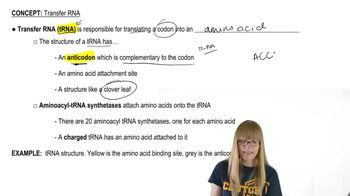What is the role of codons UAA, UGA, and UAG in translation? What events occur when one of these codons appears at the A site of the ribosome?
Consider translation of the following mRNA sequence: 5′-...AUGCAGAUCCAUGCCUAUUGA...-3′ What is the anticodon triplet sequence of the next tRNA to interact with mRNA?
 Verified step by step guidance
Verified step by step guidance
Verified video answer for a similar problem:
Key Concepts
mRNA and Codons

tRNA and Anticodons
Complementary Base Pairing

Compare and contrast the composition and structure of bacterial and eukaryotic ribosomes, identifying at least three features that are the same and three features that are unique to each type of ribosome.
Consider translation of the following mRNA sequence:
5′-...AUGCAGAUCCAUGCCUAUUGA...-3′
Diagram translation at the moment the fourth amino acid is added to the polypeptide chain. Show the ribosome; label its A, P, and E sites; show its direction of movement; and indicate the position and anticodon triplet sequence of tRNAs that are currently interacting with mRNA codons.
Consider translation of the following mRNA sequence: 5′-...AUGCAGAUCCAUGCCUAUUGA...-3′ What events occur to permit the next tRNA to interact with mRNA?
The diagram of a eukaryotic ribosome shown below contains several errors.
Examine the diagram carefully, and identify each error. <>
The diagram of a eukaryotic ribosome shown below contains several errors.
Redraw the diagram, and correct each error using the mRNA sequence shown. <>

